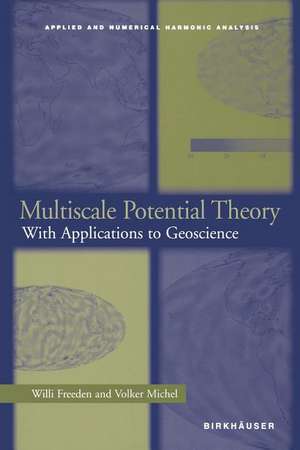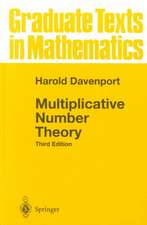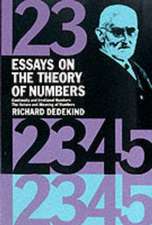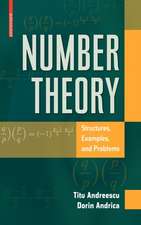Multiscale Potential Theory: With Applications to Geoscience: Applied and Numerical Harmonic Analysis
Autor Willi Freeden, Volker Michelen Limba Engleză Paperback – 12 oct 2011
| Toate formatele și edițiile | Preț | Express |
|---|---|---|
| Paperback (1) | 401.79 lei 6-8 săpt. | |
| Birkhäuser Boston – 12 oct 2011 | 401.79 lei 6-8 săpt. | |
| Hardback (1) | 406.80 lei 6-8 săpt. | |
| Birkhäuser Boston – 21 sep 2004 | 406.80 lei 6-8 săpt. |
Din seria Applied and Numerical Harmonic Analysis
-
 Preț: 399.29 lei
Preț: 399.29 lei - 20%
 Preț: 673.02 lei
Preț: 673.02 lei - 17%
 Preț: 431.76 lei
Preț: 431.76 lei - 19%
 Preț: 443.08 lei
Preț: 443.08 lei -
 Preț: 412.57 lei
Preț: 412.57 lei - 15%
 Preț: 550.04 lei
Preț: 550.04 lei - 15%
 Preț: 653.98 lei
Preț: 653.98 lei - 18%
 Preț: 1014.28 lei
Preț: 1014.28 lei - 15%
 Preț: 647.92 lei
Preț: 647.92 lei -
 Preț: 413.37 lei
Preț: 413.37 lei - 15%
 Preț: 648.74 lei
Preț: 648.74 lei - 15%
 Preț: 654.77 lei
Preț: 654.77 lei - 15%
 Preț: 636.80 lei
Preț: 636.80 lei - 15%
 Preț: 532.89 lei
Preț: 532.89 lei - 15%
 Preț: 646.62 lei
Preț: 646.62 lei - 15%
 Preț: 653.98 lei
Preț: 653.98 lei -
 Preț: 397.38 lei
Preț: 397.38 lei - 15%
 Preț: 656.43 lei
Preț: 656.43 lei - 15%
 Preț: 661.97 lei
Preț: 661.97 lei - 18%
 Preț: 957.13 lei
Preț: 957.13 lei - 24%
 Preț: 829.74 lei
Preț: 829.74 lei -
 Preț: 398.35 lei
Preț: 398.35 lei - 20%
 Preț: 569.86 lei
Preț: 569.86 lei -
 Preț: 392.21 lei
Preț: 392.21 lei - 18%
 Preț: 1121.76 lei
Preț: 1121.76 lei - 18%
 Preț: 1001.32 lei
Preț: 1001.32 lei -
 Preț: 387.75 lei
Preț: 387.75 lei - 15%
 Preț: 653.98 lei
Preț: 653.98 lei - 20%
 Preț: 567.32 lei
Preț: 567.32 lei - 20%
 Preț: 573.77 lei
Preț: 573.77 lei -
 Preț: 406.80 lei
Preț: 406.80 lei -
 Preț: 387.38 lei
Preț: 387.38 lei - 5%
 Preț: 1168.71 lei
Preț: 1168.71 lei -
 Preț: 400.85 lei
Preț: 400.85 lei -
 Preț: 398.15 lei
Preț: 398.15 lei - 15%
 Preț: 644.49 lei
Preț: 644.49 lei - 19%
 Preț: 575.84 lei
Preț: 575.84 lei - 15%
 Preț: 703.71 lei
Preț: 703.71 lei - 20%
 Preț: 334.71 lei
Preț: 334.71 lei - 15%
 Preț: 525.54 lei
Preț: 525.54 lei -
 Preț: 405.06 lei
Preț: 405.06 lei - 15%
 Preț: 536.96 lei
Preț: 536.96 lei
Preț: 401.79 lei
Nou
Puncte Express: 603
Preț estimativ în valută:
76.89€ • 79.98$ • 63.48£
76.89€ • 79.98$ • 63.48£
Carte tipărită la comandă
Livrare economică 14-28 aprilie
Preluare comenzi: 021 569.72.76
Specificații
ISBN-13: 9781461273950
ISBN-10: 1461273951
Pagini: 532
Ilustrații: XVIII, 510 p.
Dimensiuni: 155 x 235 x 28 mm
Greutate: 0.74 kg
Ediția:Softcover reprint of the original 1st ed. 2004
Editura: Birkhäuser Boston
Colecția Birkhäuser
Seria Applied and Numerical Harmonic Analysis
Locul publicării:Boston, MA, United States
ISBN-10: 1461273951
Pagini: 532
Ilustrații: XVIII, 510 p.
Dimensiuni: 155 x 235 x 28 mm
Greutate: 0.74 kg
Ediția:Softcover reprint of the original 1st ed. 2004
Editura: Birkhäuser Boston
Colecția Birkhäuser
Seria Applied and Numerical Harmonic Analysis
Locul publicării:Boston, MA, United States
Public țintă
ResearchCuprins
1 Introduction.- 2 Preliminary Tools.- 2.1 Basic Settings.- 2.2 Spherical Nomenclature.- 2.3 Sphere Oriented Potential Theory.- 2.4 Exercises.- I Well-Posed Problems.- 3 Boundary-Value Problems of Potential Theory.- 4 Boundary-Value Problems of Elasticity.- II Ill-Posed Problems.- 5 Satellite Problems.- 6 The Gravimetry Problem.- 7 Conclusion.- 8 Hints for the Solution of the Exercises.- References.
Recenzii
"The book is devoted to well-posed and ill-posed boundary-value problems arising in geoscience, elasticity, gravimetry and other areas, including satellite problems. New mathematical methods and fast computational schemes based on harmonic analysis and wavelet transforms are developed…. The book may be used for graduate-level courses in geomathematics, applied mathematics, and geophysics. It is also an up-to-date reference text for geoscientists, applied mathematicians, and engineers." —Zentralblatt MATH
"Potential theory is a classical area in mathematics which for over 200 years has attracted and still attracts attention. Famous mathematicians have contributed. At the beginning of the 19th century it was Laplace, Poisson, Gauss, Green, both F. and C. Neumann, Helmholtz, Dirichlet and others. In the last century axiomatic, fine, probabilistic, discrete, and nonlinear potential theory arose.
The present book is written for applications in geodesy and geophysics and is hence devoted to classical potential theory with particular attention to wavelet approximation.... Each chapter is concluded with exercises which have solution hints at the end of the book.... The book is a self-contained and unique presentation of multiscale potential theory, interesting for applied mathematicians, geophysicists, etc. and proper even for students." —Mathematical Reviews
"Potential theory is a classical area in mathematics which for over 200 years has attracted and still attracts attention. Famous mathematicians have contributed. At the beginning of the 19th century it was Laplace, Poisson, Gauss, Green, both F. and C. Neumann, Helmholtz, Dirichlet and others. In the last century axiomatic, fine, probabilistic, discrete, and nonlinear potential theory arose.
The present book is written for applications in geodesy and geophysics and is hence devoted to classical potential theory with particular attention to wavelet approximation.... Each chapter is concluded with exercises which have solution hints at the end of the book.... The book is a self-contained and unique presentation of multiscale potential theory, interesting for applied mathematicians, geophysicists, etc. and proper even for students." —Mathematical Reviews
Textul de pe ultima copertă
This self-contained book provides a basic foundation for students, practitioners, and researchers interested in some of the diverse new areas of multiscale (geo)potential theory. New mathematical methods are developed enabling the gravitational potential of a planetary body to be modeled and analyzed using a continuous flow of observations from land or satellite devices. Harmonic wavelet methods are introduced, as well as fast computational schemes and various numerical test examples.
The work is divided into two main parts: Part I treats well-posed boundary-value problems of potential theory and elasticity; Part II examines ill-posed problems such as satellite-to-satellite tracking, satellite gravity gradiometry, and gravimetry. Both sections demonstrate how multiresolution representations yield Runge–Walsh type solutions that are both accurate in approximation and tractable in computation.
Topic and key features:
* Comprehensive coverage of topics which, thus far, are only scattered in journal articles and conference proceedings
* Important applications and developments for future satellite scenarios; new modelling techniques involving low-orbiting satellites
* Multiscale approaches for numerous geoscientific problems, including geoidal determination, magnetic field reconstruction, deformation analysis, and density variation modelling
* Multilevel stabilization procedures for regularization
* Treatment of the real Earth’s shape as well as a spherical Earth model
* Modern methods of constructive approximation
* Exercises at the end of each chapter and an appendix with hints to their solutions
Models and methods presented show how various large- and small-scale processes may be addressed by a single geoscientific modelling framework for potential determination. Multiscale Potential Theory may be used as a textbook for graduate-level courses ingeomathematics, applied mathematics, and geophysics. The book is also an up-to-date reference text for geoscientists, applied mathematicians, and engineers.
The work is divided into two main parts: Part I treats well-posed boundary-value problems of potential theory and elasticity; Part II examines ill-posed problems such as satellite-to-satellite tracking, satellite gravity gradiometry, and gravimetry. Both sections demonstrate how multiresolution representations yield Runge–Walsh type solutions that are both accurate in approximation and tractable in computation.
Topic and key features:
* Comprehensive coverage of topics which, thus far, are only scattered in journal articles and conference proceedings
* Important applications and developments for future satellite scenarios; new modelling techniques involving low-orbiting satellites
* Multiscale approaches for numerous geoscientific problems, including geoidal determination, magnetic field reconstruction, deformation analysis, and density variation modelling
* Multilevel stabilization procedures for regularization
* Treatment of the real Earth’s shape as well as a spherical Earth model
* Modern methods of constructive approximation
* Exercises at the end of each chapter and an appendix with hints to their solutions
Models and methods presented show how various large- and small-scale processes may be addressed by a single geoscientific modelling framework for potential determination. Multiscale Potential Theory may be used as a textbook for graduate-level courses ingeomathematics, applied mathematics, and geophysics. The book is also an up-to-date reference text for geoscientists, applied mathematicians, and engineers.
Caracteristici
New mathematical methods are developed enabling the gravitational potential of a planetary body (the Earth) to be modeled and analyzed using a continuous flow of observations from land or satellite devices Comprehensive coverage of topics which, thus far, are only scattered in journal articles and conference proceedings Important applications and developments for future satellite scenarios; new modelling techniques involving low-orbiting satellites Multiscale approaches for numerous geoscientific problems, including geoidal determination, magnetic field reconstruction, deformation analysis, and density variation modelling Exercises at the end of each chapter and an appendix with hints to their solutions Accessible to a broad audience of grad students, geoscientists, applied mathematicians, and engineers Includes supplementary material: sn.pub/extras




















